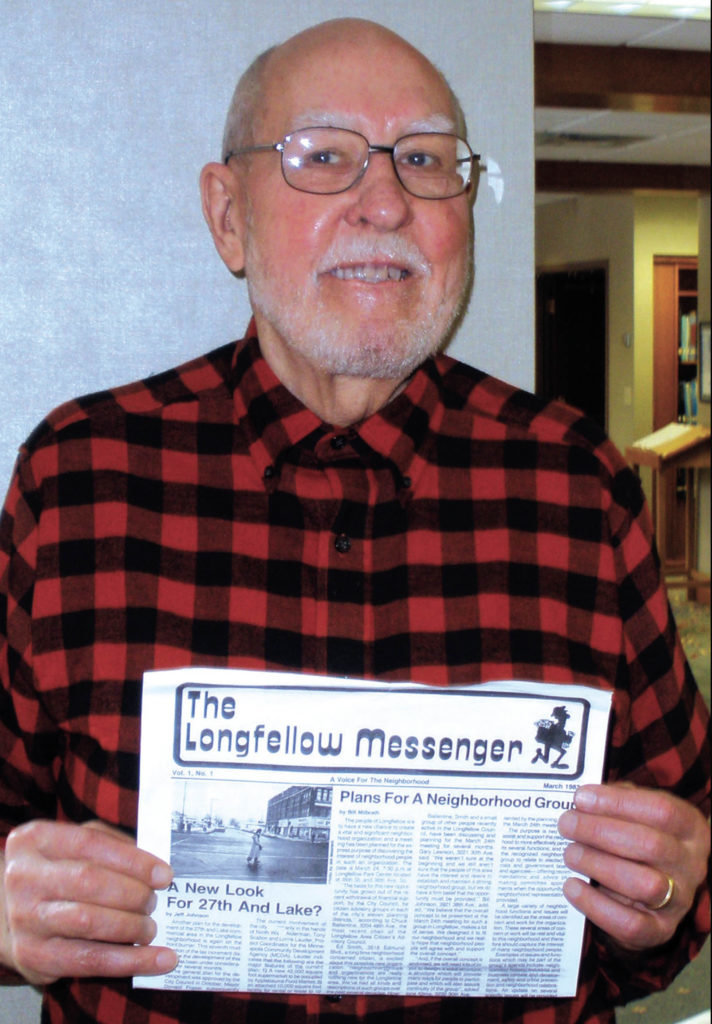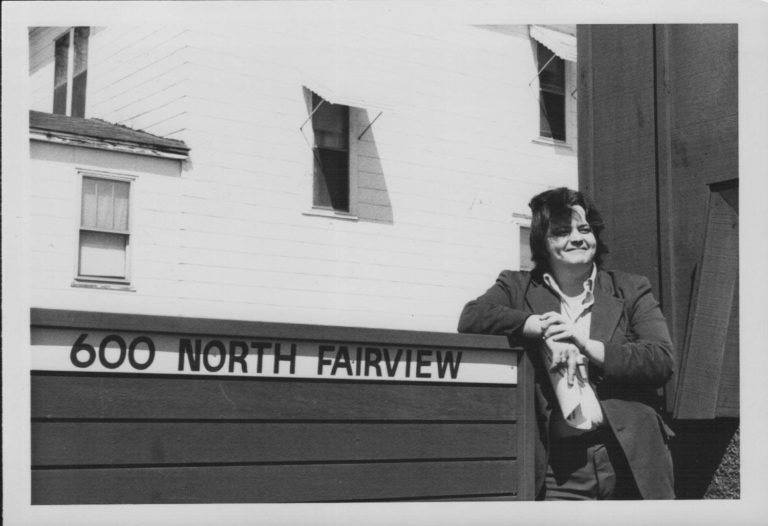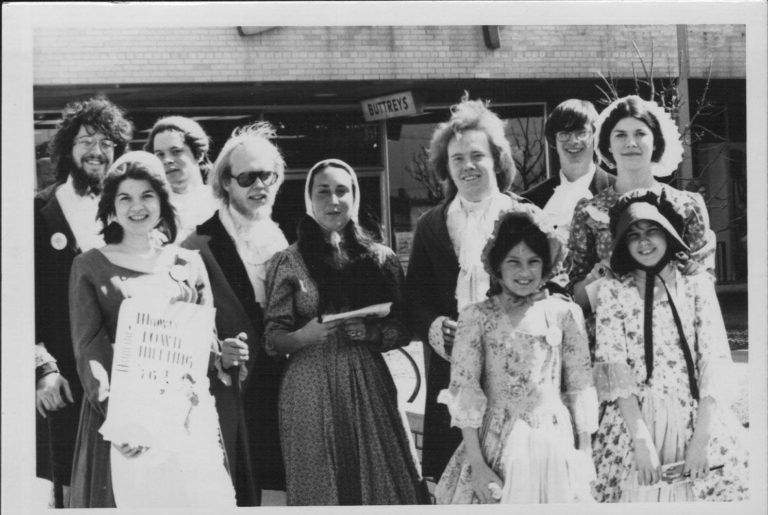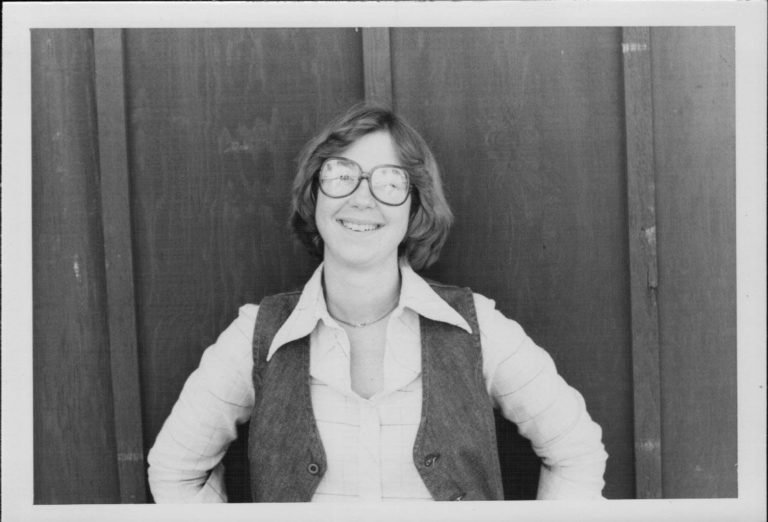The Longfellow Nokomis Messenger and the Midway Como Monitor are under new ownership beginning May 1, 2019.
 Cal deRuyter and Tim Nlseon, 1977
Cal deRuyter and Tim Nlseon, 1977Calvin deRuyter and Tim Nelson of deRuyter-Nelson Publications sold their two well-established neighborhood newspapers to south Minneapolis resident Tesha M. Christensen, who had written for the two newspapers for almost eight years.
Christensen always knew she wanted to be a writer, and was drawn to journalism at a young age when she wrote a letter to the editor that was published in the Cambridge Star newspaper.
“From that point on I was hooked. I had gotten my first glimpse into the power of the printed word,” recalled Christensen. “I wanted more. I saw how newspapers could be used to generate change in their communities, and how they could inform and engage people.”
LIFELONG LEARNER
 New owner Tesha with her two children
New owner Tesha with her two childrenShe earned a degree in English and writing in 1998 from Bethel College, where she wrote for the Clarion, and then entered the community newspaper industry. Her first job was with the same newspaper that printed her letter to the editor, then renamed the STAR newspaper. Christensen worked as the assistant editor and special sections editor of her hometown newspaper for 10 years, serving two counties and a circulation of 21,000 with a twice weekly newspaper.
Over the years, Christensen covered a range of topics in Isanti and Chisago counties, from school board levies to new county parks to crime news. “I wrote about what new businesses were coming to town, local musicians, and rodeo shows, and a story about one local resident who saved the life of another,” Christensen recalled.
“I love the ever-changing nature of this business, and how I learn something new with each story I write.”
She left the full-time workforce in March 2009 when her first baby was born, but continued writing on a part-time basis for Northstar Media, the Isanti County News, ECM Publishers/Adams Publishing Group, Twin Cities Daily Planet, RedCurrent and The Alley newspaper in the Phillips neighborhood of south Minneapolis.
From 2006 to 2012, she worked as an adjunct journalism instructor at Anoka-Ramsey Community College where she taught a variety of journalism classes and was adviser for the Cambridge Campus newspaper, the Ink Spot. She also taught for one year at Planet Homeschool, a homeschool co-op in St. Anthony, and helped launch a school newspaper written by the middle and high school students.
“I love journalism, and I am passionate about sharing journalism with kids and young adults,” stated Christensen. “They are the future, and it’s so exciting to hear their ideas.”
Christensen has served on a variety of committees and boards over the years, and is a co-founder of Team Yarn – Head Huggers (teamyarn.blogspot.com), a small non-profit dedicated to making and donating hats, shawls and lapghans to those battling cancer and other serious illnesses.
FORUM FOR COMMUNITY DISCUSSION
Christensen and longtime staff member Denis Woulfe, along with the writers and photographers who contribute to the paper, are looking forward to what the future holds for the Messenger and Monitor newspapers.
 Denis Woulfe has been working for the Monitor and Messenger since her was a college intern from Hamline.
Denis Woulfe has been working for the Monitor and Messenger since her was a college intern from Hamline.“I think what excites me about this next chapter is working to re-engage the newspapers with the communities that we serve,” observed Woulfe, who started as an intern at the Monitor while he attended Hamline University 40 years ago.
“The world has changed since each of the newspapers was founded, but the basic needs of our readers are largely the same. I think they value the work and the role of the Messenger and the Monitor, and our challenge now is to find out how to heighten that engagement and fulfill that special contract between our readers and the newspapers that enhances and enriches the communities that we serve.”
Over the years, Woulfe has serve in many different roles at the neighborhood newspapers, including editor, typesetter, managing editor, advertising manager, and more. For the past few years, he’s been busy selling ads. He has donated to the community in a number of different ways, and is currently a board member at ALLY People Solutions in the Midway which just merged with Community Involvement Programs (CIP) of Minneapolis. He is also a member of the Alumni Annual Fund Board for Hamline University.
“We dealt with many challenges over the years, but one in particular was the discussion over the role of a neighborhood newspaper and the balance between reporting what some readers saw as ‘good’ news and what others saw as ‘bad’ news,” said Woulfe. There also was the constant dialogue about what role the neighborhood newspaper had, and how it differed from the daily newspapers.
“Despite the different neighborhoods we serve with the two newspapers, the value of bringing community stakeholders together and providing a forum for community discussion has remain the constant over the years,” stated Woulfe. “It remains as important now more than ever!”
THINK PRINT IS DEAD?
 Bill Millbrath began the Messenger.
Bill Millbrath began the Messenger.Christensen agrees, and will be recruiting various people from each neighborhood to serve on an advisory board that will share story ideas and tie each story closer into the fabric of the neighborhood.
“At the Monitor and Messenger, we are here to tell the stories of our neighborhoods,” she stated. “We want to be reader-centric and make our content – both ads and articles – engaging and applicable. Print is evolving, and we’re looking ahead in innovative and creative ways. More people are reading than ever before in the history of humankind, and we want to ensure that local residents are reading their community newspaper because it is ‘News for You.’
“Think print is dead? Think again.”
When 22-year-old Calvin deRuyter bought the Monitor in 1975 for $1 from a man who thought it had no future, he had no idea what he was getting himself into.
Forty-four years later he’s perfected the art of dealing with challenges in the job he’s loved.
“You face it, yell and scream at yourself and the world, then buck up and try to come up with a solution or solutions that will address the challenge,” stated deRuyter. “Isn’t that how we all face the challenges in life?”
PAPER SHARES COMMUNITY IDENTITY
deRuyter had been the editor of his student newspaper, The Oracle, at Hamline University, and started working for the Highland Villager while he took a year off between his undergraduate and graduate work in art. He volunteered to edit the first issue of the “Midway ?” – which was given the name Monitor following a neighborhood naming contest.
Some local business owners and leaders co-signed deRuyter’s first loan to get the paper started, and the Monitor joined the other community newspapers being birthed along with the neighborhood councils. Residents were seeking new ways to develop their community identity in the Cities. The first boundaries were established by the district council boundary, so the Midway Monitor followed the borders of the District 11 Hamline Midway Coalition.
“People were excited about being involved in their neighborhood and finally having, they believed, a way to have a voice in the shaping of city policy that was so prevalent in their lives,” recalled deRuyter. “The whole citizen participation movement was what shaped the paper for years. It was the same in Como when we expanded the paper to be the Midway Como Monitor.”
NELSON JOINS PAPER
 Cal deRuyter at first paid office on North Fairview.
Cal deRuyter at first paid office on North Fairview.Calvin deRuyter was one of the first people that Tim Nelson met when he enrolled at Hamline University. deRuyter was a junior and working as arts editor at the Oracle. They lived in the same dorm, and then worked together at the student newspaper. Nelson had been editor of his high school newspaper, and set his sights on a career in politics and government. He had been accepted as a graduate student in Public Affairs at Willamette University in Oregon when deRuyter asked if Nelson was interested in working for him.
“I was intrigued, but torn as to what to do,” stated Nelson. “I called my advisor at Willamette and asked for his thoughts. His response surprised me. He said, ‘Tim, Willamette has been around since 1842 and I don’t think is going anywhere. The chance to go into business for yourself may only come around once in a lifetime. Try the business, and if it doesn’t work out, you are welcome here. I look forward to hearing what you learn.’
 Cal deRuyter, 2019
Cal deRuyter, 2019“I have never decided whether that was the best advice I ever got, or the worst. It varied day to day for the last 44 years.”
Nelson began as 50 percent partner in July 1977, and deRuyter-Nelson Publications was born. The expansion into the Como neighborhood occurred in 1979. The newspaper also expanded into the Frogtown area for a brief time period but didn’t have the local ad revenue to support the growth.
The business was growing rapidly, and it was an exciting time.
“We started the typesetting business at that point, and it was an extremely fast-paced and technology-driven industry in those years,” stated Nelson. The newspaper did the typesetting for several college newspapers, including the Hamline Oracle and Bethel Clarion, as well as the Park Bugle, Equal Time, West 7th Community Reporter, Longfellow Messenger and Grand Gazetee.
PEOPLE EXCITED ABOUT PAPER
“The community was very excited about the paper in those days, and we had a constant flow of involved citizens coming to the office to share things of interest or suggest story ideas,” said Nelson. “Along with those people who believed in the paper, we also had groups we were less than popular with.”>/p>
 Hamline Student Congress 1976 bicentennial costumes promoting Town Meeting. Tim Nelson is third on left with wife Monica holding the sign.
Hamline Student Congress 1976 bicentennial costumes promoting Town Meeting. Tim Nelson is third on left with wife Monica holding the sign.A few bricks were thrown through the office windows at 600 N. Fairview in response to endorsements of political candidates. During that same time, Nelson remembers when a columnist wrote an opinion piece that was critical of the organized church. “We had a religious group that went to our advertisers and told them that if they ran an ad they would not support their business. We had many heated meetings with this group and it was not a pleasant time,” he said. “It was a rather contentious year! When the Job Corps moved in to the Bethel campus, we were also threatened by the community group who opposed that happening. They didn’t like how we were covering the events and again, threatened to go to advertisers with a boycott.”
Ironically, it is those same events that were not pleasant, such as vandalism and threats to their income base, that have also been the highlights.
“Any time a community is passionate about a topic, it’s an exciting time,” said Nelson. “Our goal is not to be loved by everyone. I have always considered the greatest compliment to be when we get complaints from both sides of a controversial issue saying that we are biased against them. That means we are providing a balanced story.”
Various issues have sparked discussion within the neighborhoods and the pages of the newspaper.
“The expansion of the Twin Cities German Immersion School is a recent issue that has stirred a lot of interest. The arrival of the Job Corps and light rail were big changes in the Midway/Como, along with the new soccer stadium,” remarked Nelson. “When Hamline was going to remove some of the houses near campus, that certainly got some folks upset. Again, it tends to be pockets within the neighborhood that are most impacted by the changes that feel the most strongly.”
 Tim Nelson, 2019
Tim Nelson, 2019According to deRuyter, “The main challenge has been the changing nature of the commercial zones that run through it and around it… Snelling, Lexington, and University avenues, and Pierce Butler Route. These have changed the nature of the neighborhood dramatically.”
REACH ACROSS THE RIVER
In 1986, deRuyter Nelson purchased the Longfellow Messenger, and expanded its reach across the river into Minneapolis. Soon after the purchase, they expanded into the Nokomis neighborhood.
The Messenger was formed in March 1983 by community activists Maureen and Bill Milbrath as a project for their retirement years. deRuyter-Nelson Publications had performed the typesetting for years, and they were the logical ones to purchase the paper. Plus, there was a family connection that they were not initially aware of. Bill had been a college fraternity mate of Nelson’s dad, and was the soloist at his parents’ wedding.
Today, the Longfellow/Nokomis Messenger has a circulation of 21,000 in the Longfellow and Nokomis areas of Minneapolis. It offers a comprehensive home delivery to 17,000 homes and an additional circulation of 4,000 at high-traffic business, church and school drop-off points. The Messenger has an estimated reach of over 50,000 readers.
The Monitor also has an estimated reach of over 50,000 residents in St. Paul’s Midway, Como and Merriam Park neighborhoods. With a circulation of 21,000, the Monitor offers comprehensive delivery to 16,000 homes and businesses and an additional circulation of 5,000 at high-traffic business, church and school drop-off points.
Over the years, deRuyter-Nelson also operated a successful graphic design business, providing design and production services to large and small corporations and government agencies. Out of personal tragedy, they created A Place to Remember, a business that published and distributed resources worldwide for families experiencing a difficult pregnancy, premature birth, or death of an infant. A Place to Remember will be closing after 25 years as deRuyter and Nelson retire.
The Monitor and Messenger gave up the longtime Iris Park Place office (1885 University Avenue W., Suite 110) four years ago, and have operated with a virtual office since then. Other shifts at the time involved Nelson handling the newspaper production and deRuyter the editor responsibilities once again, while long-time editor and sales representative Denis Woulfe began focusing only on sales.
EVOLVING INDUSTRY
 First typesetter, Lynn Middleton Koller
First typesetter, Lynn Middleton KollerThe industry is changing, but deRuyter and Nelson still believe newspapers are part of the fabric of neighborhoods.
“I think community newspapers are vital to the neighborhoods,” observed deRuyter. “We have watched so many community newspapers die so that the community journalism movement in the Cities is just a tiny fraction of what it used to be. I don’t think there is a single community that is better off because their community newspaper could not survive.
“But I also think that the residents and the businesses don’t truly grasp the importance of the cohesiveness that the neighborhood press provides. If it is used properly the community newspaper can be the place where things ‘come together’ in one place; where you can get an overview of the things going on; where you can learn about the unique businesses that are housed there; where you can learn about the neighbor who has faced a challenge, or who has overcome one.
“Where is that place if your community newspaper dies? You certainly won’t get it from the city-wide or regional press.”
Nelson has also mulled over the changing face of journalism over the past four decades that he’s been involved in it.
“I think that over the years, the papers lost some of the fire that made them more interesting in the early days. The stories became more routine, and obviously there is no way the timeliness of a monthly publication can compete with the immediacy of news spreading on social media chat groups or blogs. The need for a community newspaper in a neighborhood was diluted.
“That is not say that I don’t think that there is a need for a community newspaper or that the concept is dead. As a matter of fact, it may be more important now than ever given the fact that the daily papers are struggling to find their niche and are cutting budgets in order to compete in the electronic age. Social media does not even attempt to be objective, and although the media is constantly being accused of bias, I assure you we always attempt to bring the community both sides of an issue. It’s a matter of finding out what readers want to learn more about from their neighbors, and working to help reshape that delivery.”
WHAT’S NEXT?
Nelson and deRuyter officially retired on May 1, 2019 when they passed ownership of the Messenger and Monitor to Tesha M. Christensen, who has been a deRuyter-Nelson stringer for the past eight years and has worked in journalism for over 20 years.
What’s next for these longtime news hounds?
After balancing his newspaper business with the artwork that he picked back up 11 years ago, deRuyter plans to focus on his art business (www.calsportfolio.net). In addition to painting, he offers various classes and workshops. He and his husband, Jim, are also renovating an old schoolhouse in ??, Minn. He’s not leaving the Monitor or Messenger completely, either, as he’ll be providing bookkeeping services to the new owner.
Nelson will continue selling a support book he wrote for fathers who have experienced the death of an infant through miscarriage, stillbirth, or early infant death. The book, “A Guide For Fathers – When A Baby Dies,” is in its seventh printing.
In addition, Nelson and his wife, Monica, have four children living around the world. “It’s not always ideal having your children spread out, but at least they have chosen interesting places to visit – London, El Nido (Philippines), Phoenix and Los Angeles,” remarked Nelson. They are also fortunate to have six grandchildren living in Arizona, and are anxiously awaiting the arrival of triplet girls in California.
“Let’s just say, I’m not worried about being bored,” said Nelson. “At least while I am still able to get on a plane.”